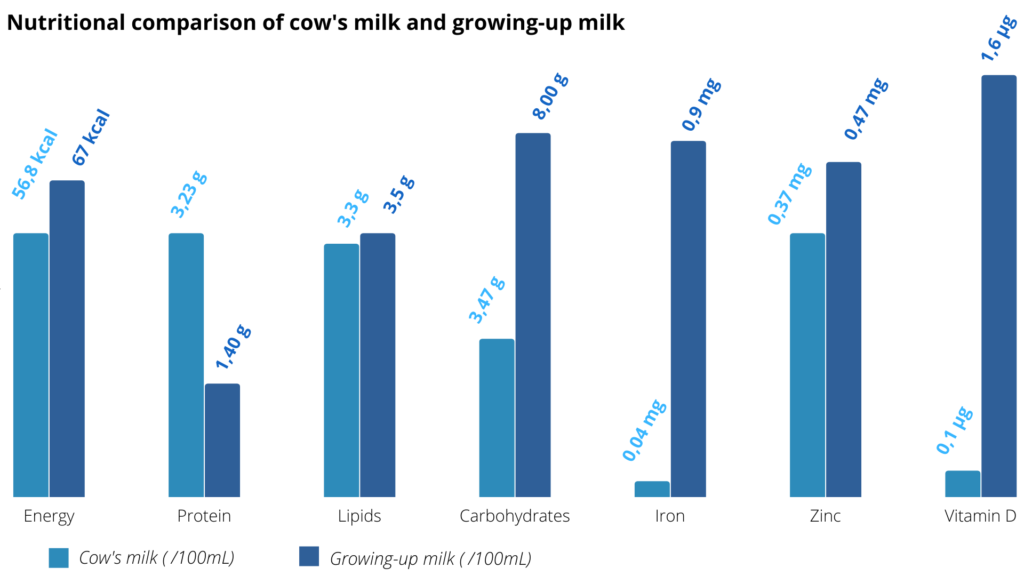What benefits do growing-up milks provide?

The WHO recommends infant feeding exclusively through breastfeeding for the first six months of life20. When breastfeeding is not possible, 1st age infant formula milk is recommended until the child is 6 months old.
Between month 4 and month 6, food diversification begins. In addition to diet, follow-up or second age formula milks can then be used in place of breastfeeding or first age infant formula milk.
From the age of one, 3rd age milks, also known as growing-up milks, or toddler milks, can be used as a dietary supplement up to the age of three. They supplement the nutritional intake during the food diversification phase of young children.
Read on to find out more about growing-up milks and the benefits they offer.
A fast-growing European market
Why use growing-up milk?
The French Paediatric Society recommends the consumption of at least 500 ml of growing-up milk from 1 year . Growing-up milk is perfectly suitable up until the child turns 3. Growing-up milk contains protein, fats, carbohydrates, vitamins and minerals and other components, the composition of which has been adapted to the specific needs of children over the age of one2 . The consumption of growing-up milk compensates for common nutritional deficiencies, such as iron and essential fatty acids.
Extensive research and innovation in growing-up milks
With the aim of better meeting the expectations and requirements of parents, research and development initiatives are being carried out by the infant nutrition industry, with a focus on:
- research into ingredients that bring the product as close as possible to breast milk.
- the development of products with the best organoleptic properties, that contribute to the development of the sensory capacities of young children15
- creating organic versions21 of the products.
- handy and eco-friendly packaging. Mobile and child-friendly packaging is in high demand15. It’s worth noting that convenience of use is the most important purchase criterion for parents15.
A dynamic early life nutrition market sector
The early life nutrition market includes products from the infant formula sector (€35.6 billion in 2019 and estimated at €53.2 billion in 2024 worldwide) and the food diversification sector. This global early life nutrition market was worth around €46.83 billion in 2019. Global Data predicts a potential of €70.33 billion by 20243 . In France, the early life nutrition market is worth over €800 million10 .
The infant formula sector is growing rapidly with high added value. Parents are increasingly opting for growing-up milks in liquid format for their ease of use9 .
An adapted and supervised nutritional quality
Young children have specific nutritional needs. Growing-up milk is specially designed to provide all the essential nutrients for proper development.
Did you know?
Growing-up milk offers a composition specially adapted to the needs of children:
● an optimal protein intake
● up to 6,000 times more essential fatty acids than cow’s milk15, excellent for the brain22
● twice as much zinc as cow’s milk15
● many vitamins including A, C, D and E15
Protein: yes, but not too much!
The infant grows by about 20 cm in the first year.
Protein is essential for child growth. It contributes to the development of the skeleton, muscles, and tissues. It is involved in many physiological processes such as immunity, and the transport of molecules and messengers.
However, too much protein is not recommended for infants. In most developed countries, the protein intake of children aged 1-3 years is higher than the recommended amount (Sharma, 2013; Chouraqui, 2019b).
It has been suggested in research literature that excess protein intake during childhood could strain a child’s renal system and may be associated with a higher risk of developing obesity or weight issues (Roland-Cachera,2016). However, the causal relationship has yet to be proven. This is why, as a precautionary measure, the ESPGHAN experts recommend a protein intake level close to the low value recommended in 2nd age regulations27.
Growing-up milks provide reduced protein levels, half as much on average than what cow’s milk provides: 1.2 to 2.3g/100ml23,29 instead of approximately 3.3 g/100ml.
The consumption of growing-up milk can therefore provide the necessary nutrients for the proper development of young children while controlling protein intake.
Lipids: essential fatty acids
For lipids, essential fatty acids (EFAs) cannot be synthesised by the child and must be provided through the diet. There are two families of EFAs:
- Omega-6, with linoleic acid (LA) as a precursor enabling the body to synthesise arachidonic acid (ARA)1.
- Omega-3, the essential precursor of which is alpha-linolenic acid (ALA), which synthesises eicosapentaenoic (EPA) and docosahexaenoic acid (DHA). However, DHA is considered essential because it cannot be synthesised in sufficient quantities by the body even in the presence of ALA1.
Omega-3 is necessary for the development and proper functioning of the retina, brain, and nervous system. The specific benefits of DHA have been proven. This is why DHA benefits from a number of health claims22
- DHA contributes to healthy brain function
- DHA consumption by the mother contributes to the normal development of the eyes of the foetus and the breastfed child
- Maternal DHA consumption also contributes to the normal development of the brain of the foetus and the breastfed child.
Sufficient intake of omega 3 is therefore essential for children13 .
The Anses has thus issued recommendations in line with those of the ESPGHAN. From 6 months to 3 years, linoleic acid intake should represent 2.7% of daily energy intake. Alpha-linolenic acid should represent 0.45%. The AFSSA recommends a DHA intake of 70 mg/day.
However, the total fat intake of children aged 1 to 3 years is below the ANSES guidelines30.
Growing-up milk can help to supplement these needs as it offers a source of essential fatty acids such as DHA.
Special focus on iron
Iron intake from a diversified diet is limited by the low amount of animal protein recommended for young children.
Iron deficiency in infants is common. Nearly 30% of children aged 12-35 months have insufficient iron intake according to the ANSES (201930). Iron contributes to healthy brain development. Iron deficiency would therefore have a negative impact on the cognitive, neurosensory and motor development of young children6 .
Growing-up milks can be a valuable source of iron in the diet of very young children. 500 ml of growing-up milk with 0.9 mg of iron per 100 ml contains 4.5 mg of iron, i.e. 90% of the nutritional intake recommended by the ANSES.
In France, the health authorities recommend the consumption of iron-enriched milk, such as growing-up milk from 1 to 3 years of age, from the time that breastfeeding stops to reduce the likelihood of iron deficiency. A research team from the Inserm, AP-HP and the University of Paris carried out a study published in the Clinical Nutrition Journal which demonstrated the benefits of these recommendations.
***
***
Growing-up milks provide protein, iron and essential fatty acids that are better suited to the needs of young children aged 1 to 3 years than other milks of animal origin.
The quality of growing-up milks
Growing-up milks are regulated by the decree of 30 March 1982. Many of them meet the composition criteria for follow-up formula milks 30.
However, there are no official regulations concerning the composition of growing-up formula milks for children over the age of one. The composition of these milks is therefore specific to each manufacturer.
However, there are recommendations from the ESPGHAN (European Society for Paediatric Gastroenterology Hepatology and Nutrition)12 ,17,18,19 that address the needs of children.
In addition to nutritional quality, early life nutrition specialists are working on improving the organoleptic quality and convenience of use of these products.
There are three concepts to consider when developing and manufacturing growing-up milks:
- adapting the product to suit the specific nutritional needs of children,
- meeting the quality standards and regulations for early life nutrition products
- anticipating the expectations of parents on convenience of use and taste
The challenge for early life nutrition manufacturers is to find the right balance between these requirements. Lactalis is committed to working with you to find your optimal market position and to develop customised products that are perfectly adapted to your needs.
For more information: please contact our Early Life Nutrition team online: info@lns-privatelabel.com
SOURCES:
[1] Turck, D. (2015). Quelle place pour les laits « Croissance »?. Archives de Pédiatrie, 22(5), 85–86. doi:10.1016/S0929-693X(15)30044-0
[2] Fantino M, Gourmet E: Nutrient intakes in 2005 by non breast-fed French children of less than 36 months (in French). Arch Pediatr 2008;15:446–455
[3] Global Data, 2020
[4] Chouraqui, 2019
[5] Vallée L. Fer et neuro-développement. Arch Pédiatr 2017;24:5S18-5S22.
[6] Briend A, Comité de nutrition de la SFP. Apports lipidiques chez l’enfant de moins de 3 ans. Arch Pediatr. 2014 Apr;21(4):424-38.
[7] L’EFSA actualise les conseils concernant les préparations pour nourrissons et les préparations de suite. 2014
[8] The interest of growing-up formulas for young children https://www.lactalisingredients.com/news/blog/the-interest-of-growing-up-formulas-for-young-children/
[10] “Marché de l’alimentation infantile : comment se démarquer ?” https://www.vitagora.com/blog/2019/demarquer-marche-alimentation-infantile
[11] Règlement 2016/127
[12] https://dumas.ccsd.cnrs.fr/dumas-01264820/document
[13]https://lesprosdelapetiteenfance.fr/bebes-enfants/nutrition/les-proteines-oui-mais-pas-trop
[15] https://www.alimentsenfance.fr/composition-lait-croissance/
[17] Journal of Pediatric Gastroenterology and Nutrition: November 2005 – Volume 41 – Issue 5 – p 580-583 doi: 10.1097/01.mpg.0000188741.46380.24 https://journals.lww.com/jpgn/Fulltext/2005/11000/Infant_Formulae__From_ESPGAN_Recommendations.5.aspx
[18] Young Child Formula: A Position Paper by the ESPGHAN Committee on Nutrition.http://www.spp.pt/UserFiles/file/Artigo_da_semana_2018/Artigo_18_04_2018.pdf
[19] Agostoni C, Decsi T, Fewtrell M, et al., ESPGHAN Committee on Nutrition. complementary feeding: a commentary by the ESPGHAN Committee on Nutrition. J Pediatr Gastroenterol Nutr 2008;46:99–110.
[20] Recommandations de l’OMS sur l’allaitement maternel jusqu’à 6 mois https://www.who.int/fr/health-topics/breastfeeding#tab=tab_2
[21] https://www.lactalisingredients.com/fr/news/blog/nutrition-infantile-un-marche-faconne-par-les-consommateurs/
[22] RÈGLEMENT (CE) No 1924/2006 DU PARLEMENT EUROPÉEN ET DU CONSEIL du 20 décembre 2006 concernant les allégations nutritionnelles et de santé portant sur les denrées alimentaires https://eur-lex.europa.eu/legal-content/FR/TXT/PDF/?uri=CELEX:02006R1924-20141213&rid=1
[23] Guides PNNS : mangerbouger.fr et article Ghisolfi J et al., Comité de Nutrition de la Société Française de Pédiatrie. Lait de vache ou lait de croissance : quel lait recommander pour les enfants en bas âge? Arch Pediatr 2011 ; 18 : 355-58.
[24] Tai EK et al. An update on adding docosahexaenoic acid (DHA) and arachidonic acid (AA) to baby formula. Food Funct 2013 ; 4 :1767-75.
[25] Anses. Actualisation des apports nutritionnels conseillés pour les acides gras. Rapport d’expertise collective. Mai 2011.
[26] Willatts P et al. Effects of long-chain PUFA supplementation in infant formula on cognitive function in later childhood. Am J Clin Nutr 2013 ; 98 (suppl) : 536S-42S.
[27] Hojsak, Young Child Formula: A Position Paper by the ESPGHAN Committee on Nutrition, 2018
[28] Arrêté du 11 avril 2008 relatif aux préparations pour nourrissons et aux préparations de suite
[30] Avis de l’Agence nationale de sécurité sanitaire de l’alimentation, de l’environnement et du travail relatif à l’actualisation des repères alimentaires du PNNS pour les enfants de 0 à 3 ans, 2019










